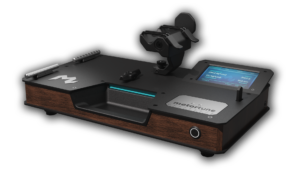Introduction
Some time ago on saitenforum.de there was a construction manual, including source code, for a device that can measure swingweight. Developed and published by Crazydoc, it was called the Crazy-Mini. The required parts were inexpensive, and with a bit of technical skill, one could build the device himself.
Unfortunately saitenforum.de is currently down, and no one knows when it will be back online.
That is why I am now making the instructions available here.
No technical skills?
No problem! Three guys joined forces to develop and build a device on their own. It’s called Metortune and can be purchased via the website metorlab.io.
This device can measure more than the CrazyMini! With the Metortune, one can measure the following very easily:
- Swingweight
- Twistweight
- Balance
- Weight
There is also the option of using the software to match or tune the rackets very easily. As if that wasn’t enough, it also comes with a sturdy case, which makes the device very portable with an additional USB power bank.
First of all, what is swingweight?
A tennis swing is a movement of the racket toward the point of impact. In contrast to static weight at rest, moments of inertia act here. This can basically be understood as the resistance of an object to a change in position. The greater this resistance, the “heavier” the racket can be swung. In contrast, a high resistance leads to an increased energy potential that can be transferred to the tennis ball during the stroke.
These moments of inertia depend on the mass distribution of an object. In contrast to an aluminium rod, the mass distribution of a tennis racket is not homogeneous, and therefore cannot simply be calculated from geometric data. Even minor deviations by the manufacturer can have a considerable influence on the moment of inertia. Devices for measuring these moments of inertia were developed in order to have an idea of this physical parameter.
To make measurements comparable, a point 100 mm from the end of the handle was defined as the pivot point for those measuring devices. In tennis, this point of inertia is called the swingweight.
If a weight is placed at a distance from this pivot point, the inertia of the racket will increase. A tuner uses this circumstance to specifically increase the swingweight with lead tape.
A reduction in swingweight can only be achieved by reducing the weight.
Formula
Added weight in grams / 1000 * (point of added weight in centimeters – 10)^2 = swingweight in kg*cm²
Example
If one adds 5 grams to the 2 o’clock (~60 cm) position of a racket, the formula is:
5 / 1000 * (60 – 10)^2 = 12.5
So the swingweight should increase by 12.5.
Licence
Crazy-Mini by Crazydoc is licensed under CC BY-NC-SA 4.0
Instruction (in German) and Files
- Instruction
DIY-Swingweightmachine_Crazy-Mini_V1.5.pdf - All the files for programming
Crazy-Mini.zip
Thanks to
- Crazydoc
